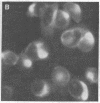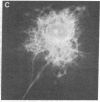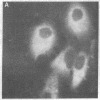Abstract
Human lymphocytes from lymph node, peripheral blood, spleen, and tumor specimens have been fused with the LICR-LON-HMy2 (LICR-2) or SKO-007 human cell lines or the NS-1 mouse myeloma line. Over 75 fusions with the three myeloma-lymphoblastoid lines have been performed. Several factors appeared to improve the fusion outcome, including maintenance of the myeloma-lymphoblastoid lines in logarithmic phase growth at greater than or equal to 95% viability, a delay of 24 hr in the introduction of aminopterin to the fused cells, and preselection of the fetal calf serum used in the medium. For a given number of lymphocytes, fusions with NS-1 produced 5-20 times more clones than fusions with LICR-2 or SKO-007, and LICR-2 produced 4 times as many clones as SKO-007. The percentage of clones secreting human immunoglobulin, the range of immunoglobulin production, and the proportion of IgM, IgA, and IgG secretors were comparable for clones derived from the three myeloma-lymphoblastoid lines. Stable Ig-secreting clones were isolated with approximately equal frequency from LICR-2 and NS-1 fusions. A number of stable clones producing human monoclonal antibodies reacting with cell-surface, cytoplasmic, or nuclear antigens have been isolated from tumor-bearing patients and normal individuals. A surface antigenic system present on normal and malignant cells has been defined with a human monoclonal antibody derived from a patient with breast cancer. Techniques for producing human monoclonal antibody now appear to be sufficiently advanced to initiate a serological dissection of the humoral immune response to cancer.
Full text
PDF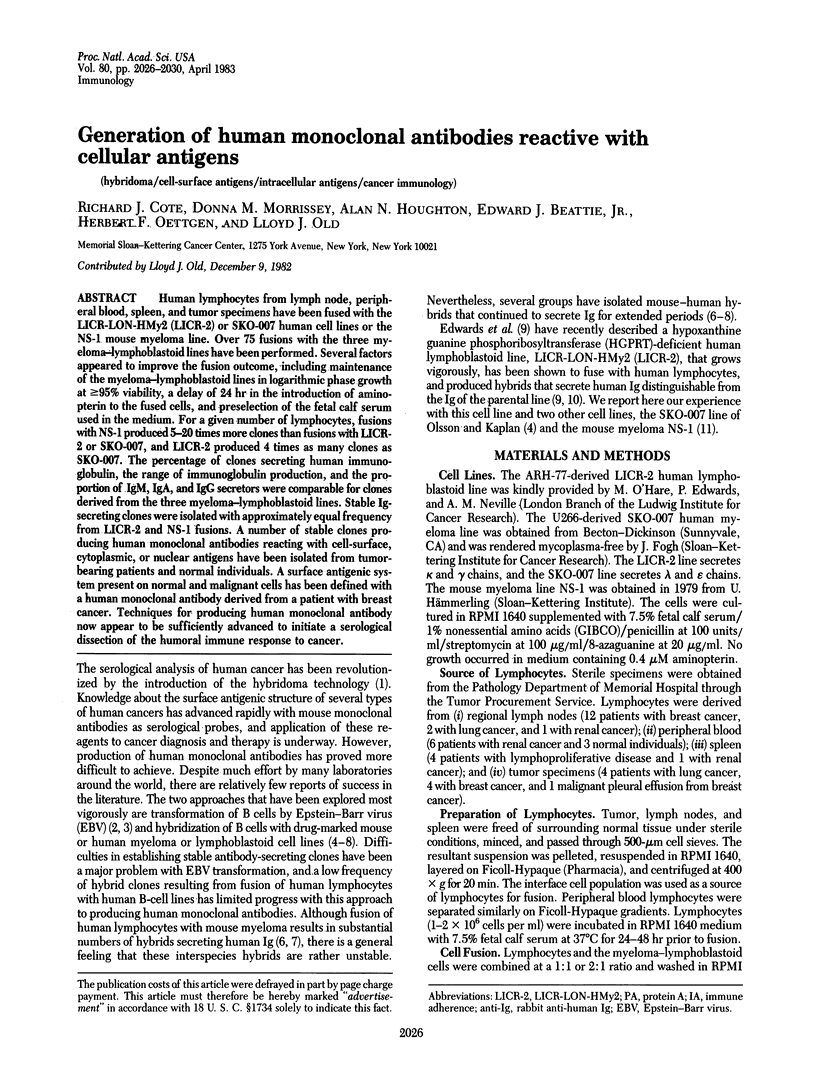
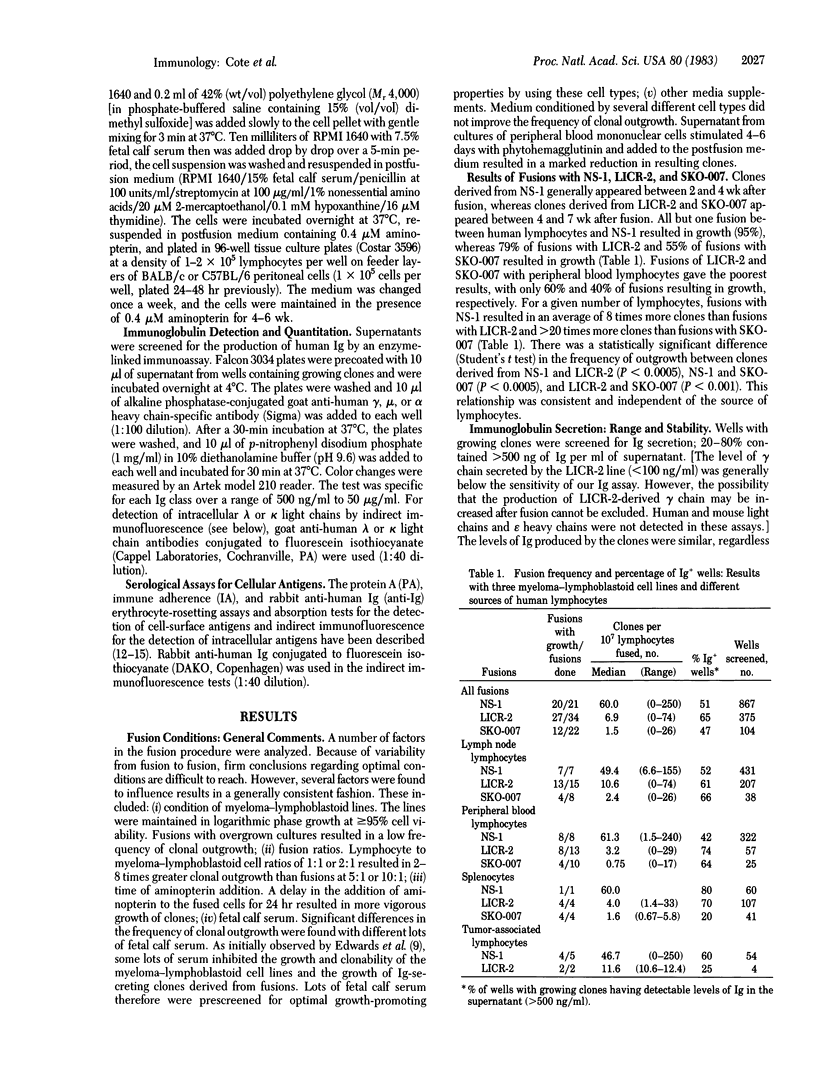
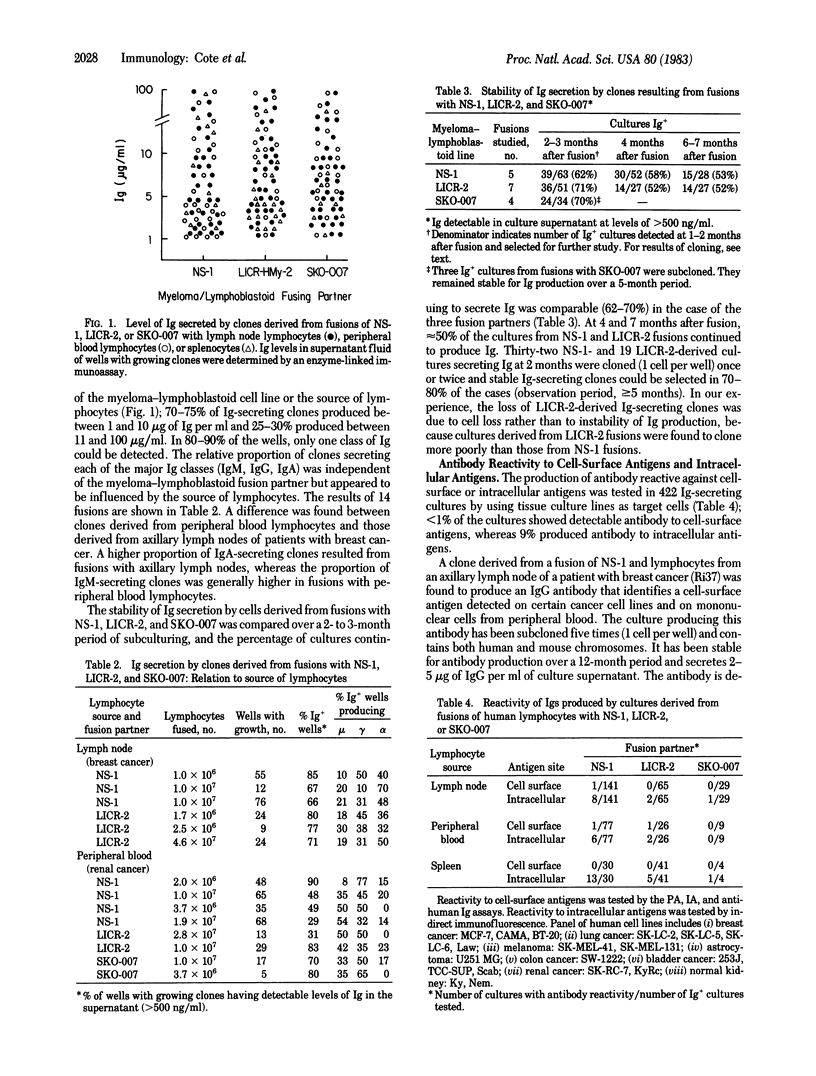
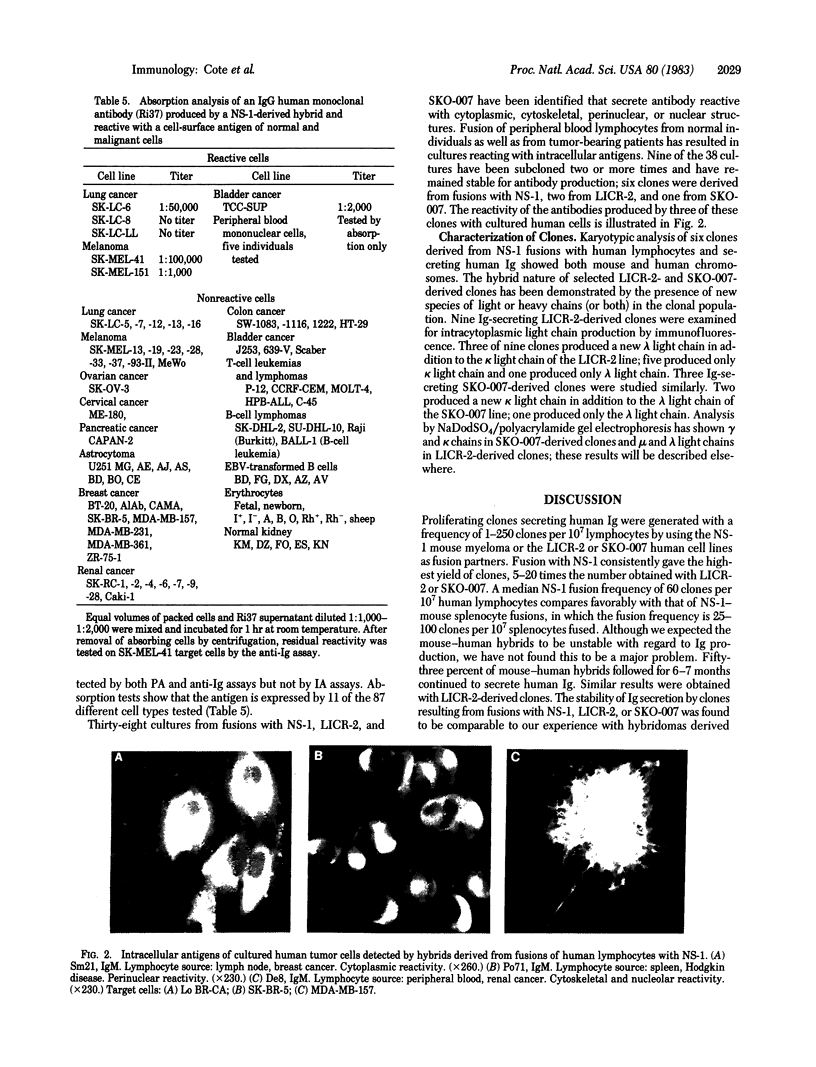
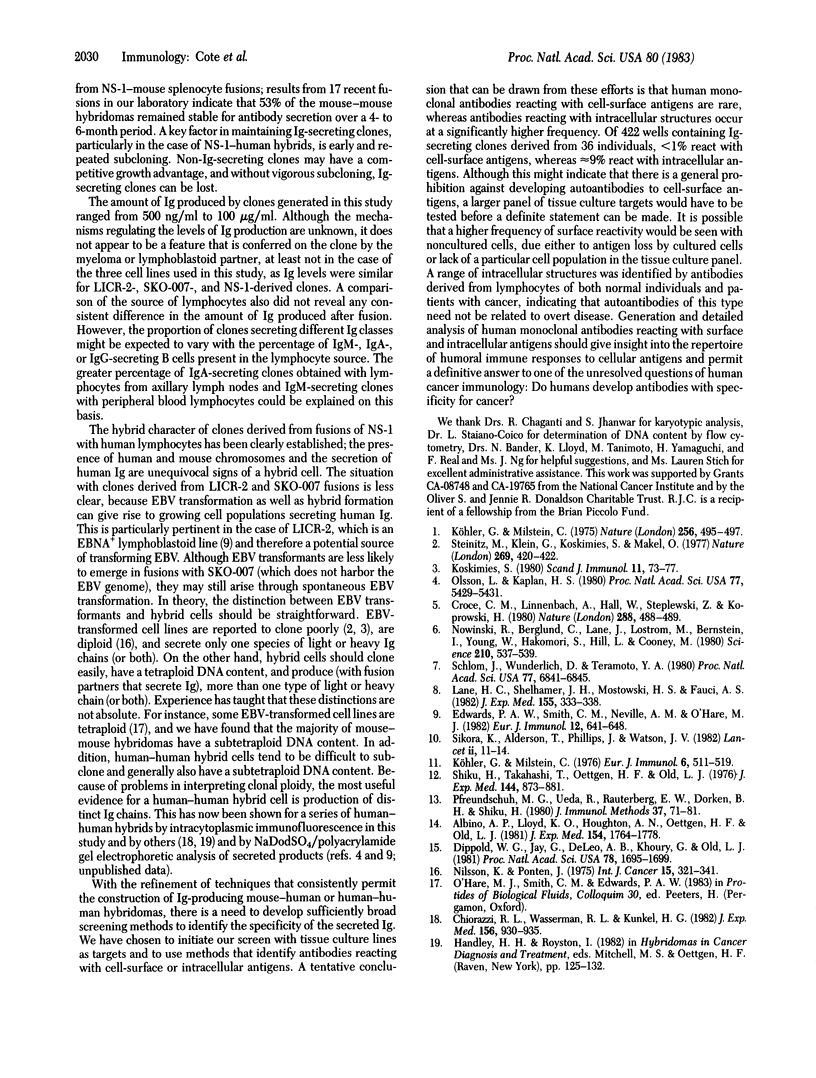
Images in this article
Selected References
These references are in PubMed. This may not be the complete list of references from this article.
- Albino A. P., Lloyd K. O., Houghton A. N., Oettgen H. F., Old L. J. Heterogeneity in surface antigen and glycoprotein expression of cell lines derived from different melanoma metastases of the same patient. Implications for the study of tumor antigens. J Exp Med. 1981 Dec 1;154(6):1764–1778. doi: 10.1084/jem.154.6.1764. [DOI] [PMC free article] [PubMed] [Google Scholar]
- Chiorazzi N., Wasserman R. L., Kunkel H. G. Use of Epstein-Barr virus-transformed B cell lines for the generation of immunoglobulin-producing human B cell hybridomas. J Exp Med. 1982 Sep 1;156(3):930–935. doi: 10.1084/jem.156.3.930. [DOI] [PMC free article] [PubMed] [Google Scholar]
- Croce C. M., Linnenbach A., Hall W., Steplewski Z., Koprowski H. Production of human hybridomas secreting antibodies to measles virus. Nature. 1980 Dec 4;288(5790):488–489. doi: 10.1038/288488a0. [DOI] [PubMed] [Google Scholar]
- Dippold W. G., Jay G., DeLeo A. B., Khoury G., Old L. J. p53 transformation-related protein: detection by monoclonal antibody in mouse and human cells. Proc Natl Acad Sci U S A. 1981 Mar;78(3):1695–1699. doi: 10.1073/pnas.78.3.1695. [DOI] [PMC free article] [PubMed] [Google Scholar]
- Edwards P. A., Smith C. M., Neville A. M., O'Hare M. J. A human-hybridoma system based on a fast-growing mutant of the ARH-77 plasma cell leukemia-derived line. Eur J Immunol. 1982 Aug;12(8):641–648. doi: 10.1002/eji.1830120804. [DOI] [PubMed] [Google Scholar]
- Koskimies S. Human lymphoblastoid cell line producing specific antibody against Rh-antigen D. Scand J Immunol. 1980;11(1):73–77. doi: 10.1111/j.1365-3083.1980.tb00210.x. [DOI] [PubMed] [Google Scholar]
- Köhler G., Milstein C. Continuous cultures of fused cells secreting antibody of predefined specificity. Nature. 1975 Aug 7;256(5517):495–497. doi: 10.1038/256495a0. [DOI] [PubMed] [Google Scholar]
- Köhler G., Milstein C. Derivation of specific antibody-producing tissue culture and tumor lines by cell fusion. Eur J Immunol. 1976 Jul;6(7):511–519. doi: 10.1002/eji.1830060713. [DOI] [PubMed] [Google Scholar]
- Lane H. C., Shelhamer J. H., Mostowski H. S., Fauci A. S. Human monoclonal anti-keyhole limpet hemocyanin antibody-secreting hybridoma produced from peripheral blood B lymphocytes of a keyhole limpet hemocyanin-immune individual. J Exp Med. 1982 Jan 1;155(1):333–338. doi: 10.1084/jem.155.1.333. [DOI] [PMC free article] [PubMed] [Google Scholar]
- Nilsson K., Pontén J. Classification and biological nature of established human hematopoietic cell lines. Int J Cancer. 1975 Feb 15;15(2):321–341. doi: 10.1002/ijc.2910150217. [DOI] [PubMed] [Google Scholar]
- Nowinski R., Berglund C., Lane J., Lostrom M., Bernstein I., Young W., Hakomori S. I., Hill L., Cooney M. Human monoclonal antibody against Forssman antigen. Science. 1980 Oct 31;210(4469):537–539. doi: 10.1126/science.7423202. [DOI] [PubMed] [Google Scholar]
- Olsson L., Kaplan H. S. Human-human hybridomas producing monoclonal antibodies of predefined antigenic specificity. Proc Natl Acad Sci U S A. 1980 Sep;77(9):5429–5431. doi: 10.1073/pnas.77.9.5429. [DOI] [PMC free article] [PubMed] [Google Scholar]
- Pfreundschuh M. G., Ueda R., Rauterberg E. W., Dörken B. H., Shiku H. Comparison of multiple rosetting assays for detecting antibody reactivity of different immunoglobulin classes against surface antigens of benign and malignant tissue culture cells. J Immunol Methods. 1980;37(1):71–81. doi: 10.1016/0022-1759(80)90182-9. [DOI] [PubMed] [Google Scholar]
- Schlom J., Wunderlich D., Teramoto Y. A. Generation of human monoclonal antibodies reactive with human mammary carcinoma cells. Proc Natl Acad Sci U S A. 1980 Nov;77(11):6841–6845. doi: 10.1073/pnas.77.11.6841. [DOI] [PMC free article] [PubMed] [Google Scholar]
- Shiku H., Takahashi T., Oettgen H. F. Cell surface antigens of human malignant melanoma. II. Serological typing with immune adherence assays and definition of two new surface antigens. J Exp Med. 1976 Oct 1;144(4):873–881. doi: 10.1084/jem.144.4.873. [DOI] [PMC free article] [PubMed] [Google Scholar]
- Sikora K., Alderson T., Phillips J., Watson J. V. Human hybridomas from malignant gliomas. Lancet. 1982 Jan 2;1(8262):11–14. doi: 10.1016/s0140-6736(82)92556-9. [DOI] [PubMed] [Google Scholar]
- Steinitz M., Klein G., Koskimies S., Makel O. EB virus-induced B lymphocyte cell lines producing specific antibody. Nature. 1977 Sep 29;269(5627):420–422. doi: 10.1038/269420a0. [DOI] [PubMed] [Google Scholar]



